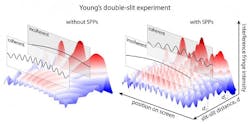Brown University researchers use SPPs to alter coherence of light
In a paper published in the journal Science Advances, Brown University (Providence, RI) researchers show that they can use surface plasmon polaritons (SPPs)--propagating electromagnetic waves confined at a metal-dielectric interface--to transform light from completely incoherent to almost fully coherent and vice versa. The ability of SPPs to modulate coherence could be useful in a wide variety of applications from structural coloration and optical communication to beam shaping and microscopic imaging.
RELATED ARTICLE: Low-loss waveguide for surface plasmon polaritons may help drastically shrink integrated photonics
"There had been some theoretical work suggesting that coherence modulation was possible, and some experimental results showing small amounts of modulation," said Dongfang Li, a postdoctoral researcher in Brown's School of Engineering and the study's lead author. "But this is the first time very strong modulation of coherence has been realized experimentally [see video]."
Coherence deals with the extent to which propagating electromagnetic waves are correlated with each other. Lasers, for example, emit light that's highly coherent, meaning the waves are strongly correlated. The sun and incandescent light bulbs emit weakly correlated waves, which are generally said to be "incoherent", although, more precisely, they are characterized by low yet measurable degrees of coherence.
"Coherence, like color and polarization, is a fundamental property of light," said Domenico Pacifici, an associate professor of engineering and physics at Brown and coauthor of the research. "We have filters that can manipulate the color of light and we have things like polarizing sunglasses that can manipulate polarization. The goal with this work was to find a way to manipulate coherence like we can these other properties."
To do that, Li and Pacifici took a classic experiment used to measure coherence, Young's double slit, and turned it into a device that can modulate coherence of light by controlling and finely tuning the interactions between light and electrons in metal films.
In the classic double-slit experiment, an opaque barrier is placed between a light source and a detector. The light passes through two parallel slits in the barrier to reach the detector on the other side. If the light shown on the barrier is coherent, the rays emanating from the slits will interfere with each other, creating an interference pattern on the detector--a series of bright and dark bands called interference fringes. The extent to which the light is coherent can be measured by the intensity of bands. If the light is incoherent, no bands will be visible.
"As this is normally done, the double-slit experiment simply measures the coherence of light rather than changing it," Pacifici said. "But by introducing surface plasmon polaritons, Young's double slits become a tool not just for measurement but also modulation."
To do that, the researchers used a thin metal film as the barrier in the double slit experiment. When the light strikes the film, SPPs--ripples of electron density created when the electrons are excited by light--are generated at each slit and propagate toward the opposite slit. "The surface plasmon polaritons open up a channel for the light at each slit to talk to each other," Li said. "By connecting the two, we're able to change the mutual correlations between them and therefore change the coherence of light."
In essence, surface plasmon polaritons are able to create correlation where there was none, or to cancel any existing correlation that was there, depending on the nature of the light coming in and the distance between the slits.
One of the study's key results is the strength of the modulation they achieved. The technique is able to modulate coherence across a range from 0% (totally incoherent) to 80% (nearly full coherence). Modulation of such strength has never been achieved before, the researchers say, and it was made possible by using nanofabrication methods that allowed to maximize the generation efficiencies of surface plasmon polaritons existing on both surfaces of the slitted screen.
This initial proof-of-concept work was done at the micrometer scale, but Pacifici and Li say there's no reason why this couldn't be scaled up for use in a variety of settings. "We've broken a barrier in showing that it's possible to do this," Pacifici said. "This clears the way for new two-dimensional beam shapers, filters and lenses that can manipulate entire optical beams by using the coherence of light as a powerful tuning knob."
SOURCE: Brown University; http://news.brown.edu/articles/2017/10/coherence
About the Author

Gail Overton
Senior Editor (2004-2020)
Gail has more than 30 years of engineering, marketing, product management, and editorial experience in the photonics and optical communications industry. Before joining the staff at Laser Focus World in 2004, she held many product management and product marketing roles in the fiber-optics industry, most notably at Hughes (El Segundo, CA), GTE Labs (Waltham, MA), Corning (Corning, NY), Photon Kinetics (Beaverton, OR), and Newport Corporation (Irvine, CA). During her marketing career, Gail published articles in WDM Solutions and Sensors magazine and traveled internationally to conduct product and sales training. Gail received her BS degree in physics, with an emphasis in optics, from San Diego State University in San Diego, CA in May 1986.
